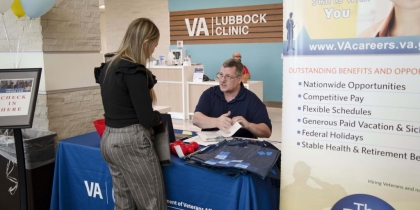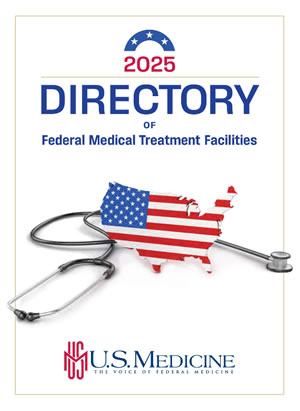Legislators Are Seeing Red

Colby Yarnell, Human Resource Specialist, checks-in an applicant at the Lubbock VA Clinic Hiring Fair last year. The Lubbock VA Clinic hosted a hiring fair for the community and welcomed over 170 potential candidates to the event. Increased hiring is one of the causes of a budget shortfall this fiscal year. VA Photo by Emily Smallwood, Public Affairs Officer
WASHINGTON, DC — VA is projecting a $2.88 billion budget shortfall for the remainder of fiscal year 2024 and another $12 billion for FY2025. This comes after VA leaders spent this spring assuring Congress that its FY2025 budget request, while lean, would be sufficient to do the job.
Last month, the chief financial officers of VBA and VHA met with key members of Congress to break the news that VA would need additional funding this fiscal year in order to pay the higher-than-expected cost of compensation and readjustment benefits payments and that it would fall short next year due primarily to increased hiring needs.
In March, VA requested a little less than $370 billion for FY2025. While it represented an approximately 13% increase over this year’s budget, the department was required to cut corners due to congressional caps. VA Secretary Denis McDonough described it as a “maintenance budget” and said it represented some “tough choices” that included significant cuts to IT and infrastructure.
Most notably, the proposed budget supported 10,000 fewer staff than in 2024. According to VA leaders at the time, this past year’s hiring surge, combined with an improved retention rate, would allow VA to draw down its workforce, leaving positions open as people retire.
Legislators were skeptical of this plan when it was presented, and in June VA nurses protested outside the department’s headquarters in Washington, DC, stating that VA’s practice of leaving positions unfilled as a way to cut costs was contributing to staff burnout and putting patient safety at risk.
Now, VA is projecting it will need to support 22,000 more employees in FY2025 than it had previously projected. Of those, 5,000 still need to be hired.
Rep. Mike Bost (R-IL), chairman of the House Committee on Veterans’ Affairs, sent a letter to McDonough expressing his confusion and displeasure at what he sees as mismanagement by VA.
‘180-degree Reversal’
“Not only have your chief financial officers thrown out the dollar amounts requested for many key accounts, they have abandoned many of the estimates and projections that underpinned their budget. This is not just fiscal mismanagement, it is strategic whiplash,” Bost wrote. “[The hiring change] is a 180-degree reversal from [VA Under Secretary for Health] Dr. Elnahal’s statement in February 2024 that ‘we have the nationwide staffing level we need to accomplish this important mission.’”
Bost suggested that the hiring increase was part of an orchestrated effort by VA leaders to draw veterans back to VA facilities and away from community care.
“I am concerned that some of these [hiring increases] represent VHA’s continued ill-fated campaign to reduce community care utilization, ignoring the myriad personal or medical reasons why individual veterans choose to get their care in the community,” he said.
The expansion of community care has been a hot topic among legislators during recent budget talks with VA officials presenting evidence community care be more expensive, and veterans generally fare better at VA-run facilities. Community-care costs have been one of the fastest expanding parts of VA’s budget in recent years, with the department asking for $30 billion for community care in FY2025. This compares to $74 billion for medical services at VA facilities.
Next year’s shortfall also will be driven by an expected $3.87 billion increase in pharmaceutical and prosthetics spending.
According to Bost, the explanations VA provided for this increase were “spotty at best” and included a round $1 billion for “managing unspecified chronic diseases,” with VA financial leaders speculating that demand for Ozempic might be part of the cause. No explanation was given for the increase in prosthetics costs.
The $2.88 billion needed this year to pay veterans’ benefits comes as less of a surprise. As of March, VA had received more than 1.3 million PACT Act-related claims, with veterans taking advantage of the toxic exposure legislation to receive compensation for covered conditions. This includes veterans already receiving benefits who are applying for increased compensation.
In April, McDonough testified that the VA was experiencing less of a surge than expected, but that the peak might not have been reached yet.
“The risk is that we over-enrolled veterans,” he told legislators. “If that’s the case, we may be coming back here to talk about [a budget increase].”
With veterans’ benefits hanging in the balance, it’s likely Congress will grant the budget increase. However, McDonough will likely be called back to Capitol Hill soon to testify on how this shortfall came about.
Bost’s letter to the VA secretary included a number of pressing questions and demands, including whether Undersecretary for Health Shereef Elnahal, MD, intentionally misled Congress as to VA’s hiring needs, a detailed explanation of the pharmaceutical and prosthetics cost increase and a breakdown of the 10 VA facilities with the largest expected hiring increases along with their community-care obligations for the last several years.

